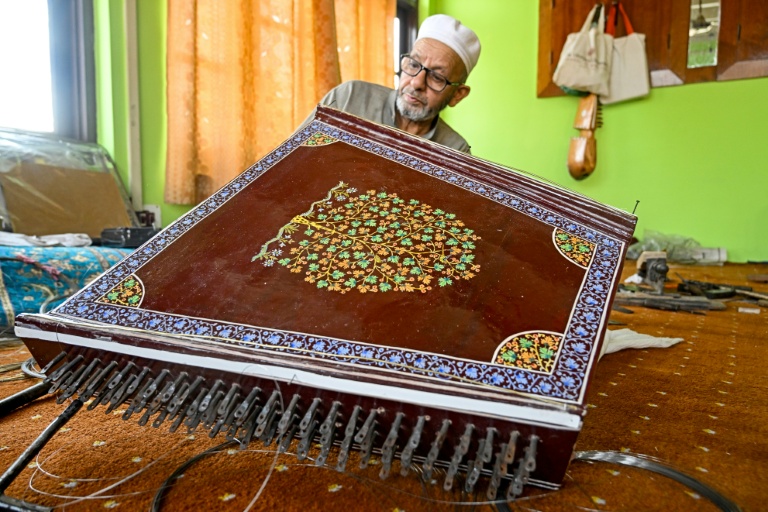World
Preserving Tradition: Kashmiri Santoor Faces Uncertain Future

In the heart of Srinagar, Kashmir’s main city, 78-year-old Ghulam Mohammad Zaz continues to craft the traditional Kashmiri santoor, a musical instrument that has been part of his family’s heritage for eight generations. Working in a modest workshop filled with the scent of aged wood, Zaz produces between eight to ten instruments each year, selling them for approximately 50,000 rupees (around $565).
Zaz reflects on the craft’s uncertain future, stating, “Seven generations have worked and I am the eighth; I have no guarantee anyone after me will do this work.” He notes that the knowledge of making the santoor is fading, with no one in his family or community currently able to continue the tradition. The santoor, a stringed instrument played with hammers, has long been integral to Kashmir’s musical identity, particularly within its sufiana musiqi tradition.
Historical Significance and Cultural Integration
The santoor has deep historical roots in the region, often associated with the tranquil sounds of mystical music that once attracted musicians from as far as Iran. According to Muzaffar Bhat, a music professor at a government college in Anantnag, Persian musicians played a significant role in the development of this instrument, which was adapted into Kashmiri music.
In the mid-20th century, the santoor experienced a resurgence in popularity due to the influential Indian musician Shivkumar Sharma, who utilized the instrument in classical music. This brought the santoor to the forefront of Indian classical circles, expanding its reach beyond traditional Kashmiri gatherings.
Despite its rich heritage, the instrument faces competition from Western music and contemporary trends, which has led to a decline in its prominence. Bhat acknowledges that many traditional Kashmiri instruments have been sidelined, resulting in fewer patrons and diminishing interest from younger generations.
A Glimmer of Hope
Despite the challenges, there are signs of revival. Bhat notes a growing interest among young musicians in traditional instruments, suggesting that a new trend is emerging. “Since the last few years, a new trend has started. Our youngsters have started to learn our traditional instruments,” he explains.
Zaz continues to sell his instruments not only within Kashmir but also receives orders from Europe and the Middle East, demonstrating a demand for authentic craftsmanship outside of his local market. His story encapsulates a broader narrative about the preservation of cultural identity in a rapidly changing world.
As Kashmir navigates ongoing political tensions and a complex history since its division between India and Pakistan in 1947, the future of the santoor reflects both the challenges and resilience of its cultural landscape. The conflict has deeply impacted the region, with recent clashes resulting in significant casualties. Yet, amid these challenges, the dedication of artisans like Zaz and the renewed interest from younger generations offer a glimmer of hope for the survival of Kashmir’s musical heritage.
In a world increasingly influenced by globalization, the preservation of local traditions like the santoor is vital. As Zaz continues his work, he embodies the spirit of a rich cultural legacy that still reverberates within Kashmir’s identity.
-

 Science3 months ago
Science3 months agoToyoake City Proposes Daily Two-Hour Smartphone Use Limit
-

 Top Stories3 months ago
Top Stories3 months agoPedestrian Fatally Injured in Esquimalt Collision on August 14
-

 Health3 months ago
Health3 months agoB.C. Review Reveals Urgent Need for Rare-Disease Drug Reforms
-

 Technology3 months ago
Technology3 months agoDark Adventure Game “Bye Sweet Carole” Set for October Release
-

 World3 months ago
World3 months agoJimmy Lai’s Defense Challenges Charges Under National Security Law
-

 Lifestyle3 months ago
Lifestyle3 months agoVictoria’s Pop-Up Shop Shines Light on B.C.’s Wolf Cull
-

 Technology3 months ago
Technology3 months agoKonami Revives Iconic Metal Gear Solid Delta Ahead of Release
-

 Technology3 months ago
Technology3 months agoApple Expands Self-Service Repair Program to Canada
-

 Technology3 months ago
Technology3 months agoSnapmaker U1 Color 3D Printer Redefines Speed and Sustainability
-

 Technology3 months ago
Technology3 months agoAION Folding Knife: Redefining EDC Design with Premium Materials
-

 Business3 months ago
Business3 months agoGordon Murray Automotive Unveils S1 LM and Le Mans GTR at Monterey
-

 Technology3 months ago
Technology3 months agoSolve Today’s Wordle Challenge: Hints and Answer for August 19









